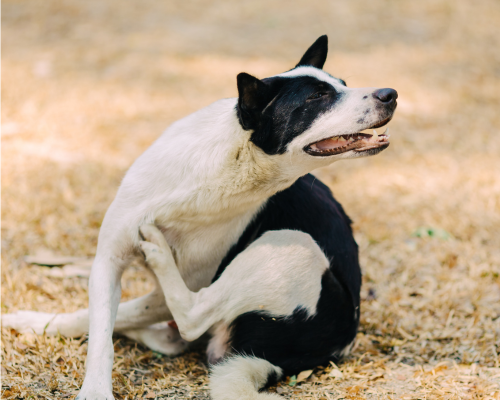What Color Is a Dog's Skin Under Their Coat?
What Color Is a Dog's Skin Under Their Coat?

Vet Reviewed

By: Sarah Hodgson
January 3, 2024
- Posted in Dogs
Table of Contents
We all know that dogs have beautiful arrays of colors and patterns in their coats. From sleek black to fluffy white, dogs come in an astonishing variety of shades. But have you ever wondered what color lies beneath that furry coat?
In this article, we will explore what color skin they have under that coat of theirs.
Let's dive in!
What Color is a Dog's Skin?
Let's just jump straight into the question. What color is their skin?
A dog's skin can be pink, black, brown, or spotted. The color of a dog's skin is primarily determined by the concentration of melanin, the pigment responsible for skin and hair color. Dogs with a higher concentration of melanin will have darker skin, while those with less melanin will have lighter skin.
Dogs with lighter-colored coats often have pink or light-colored skin, while those with darker coats may have black or darker pigmentation. This is why you may notice variations in skin color between different breeds or even within individuals of the same breed.
Do Dogs Have Different Color Skin?
Yes, dogs can indeed have different color skin. Just as with fur, the color of a dog's skin can vary greatly. Some dogs may have pink or light skin, while others may have black or dark brown skin. The color of a dog's skin is influenced by genetics and breed characteristics.
For example, dogs with light-colored or white fur often have pink skin, while dogs with dark fur tend to have darker skin. Additionally, certain breeds are more prone to having specific skin colors. For instance, the Chinese Crested breed often has spotted skin, which can be a range of colors.
Is Dog Skin the Same Color as Their Fur?
While the color of a dog's skin is closely associated with the color of their fur, it is not always the same. In some cases, the skin color may match the fur color, creating a harmonious blend. However, there are instances where the skin color contrasts with the fur color, creating a striking visual effect. For example, a dog with a white coat may have pink skin, or a dog with a black coat may have dark brown or black skin.
These variations in skin color add to the unique beauty of each individual dog.

Can a Dog's Skin Change Color?
Yes, a dog's skin can change color under certain circumstances. One common cause of skin color change is exposure to the sun. Just like humans, dogs can get sunburned, which can result in red or discolored skin. Prolonged exposure to the sun can also cause the skin to darken or develop dark spots. Another factor that can influence skin color change is age. As dogs mature, their skin may undergo pigmentation changes, resulting in a different color than when they were younger. Additionally, certain health conditions or allergies can cause the skin to become inflamed or discolored.
Why Will a Dog's Skin Change Color?
A dog's skin can change color for various reasons, including health issues and external factors. One of the most common causes is allergies. When a dog has an allergic reaction, their skin may become red, inflamed, or develop rashes. This can lead to temporary changes in skin color. Other health conditions, such as hormonal imbalances or infections, can also affect the color of a dog's skin. Additionally, external factors like exposure to the sun, chemicals, or certain medications can cause pigmentation changes in the skin.
Skin Conditions that can Affect a Dog's Skin Color
It is essential to be aware of skin conditions that can impact a dog's skin color. One such condition is hyperpigmentation, which causes darkening of the skin due to an increased production of melanin. On the other hand, hypopigmentation can occur when there is a decrease in melanin production, resulting in lighter or white patches of skin. Other skin conditions that can affect a dog's skin color include seborrhea, dermatitis, and alopecia. If you notice any changes in your dog's skin color or if they are experiencing discomfort, it is crucial to consult with a veterinarian for an accurate diagnosis and appropriate treatment.
Signs of a Healthy Dog's Skin
A healthy dog's skin will typically have certain characteristics that indicate its well-being.
- Firstly, the skin should be smooth and free from any lumps or bumps. It should also be elastic and supple, allowing for easy movement.
- A healthy dog's skin is neither too dry nor too oily, striking the right balance.
- The color of the skin should be consistent and uniform, corresponding to the dog's breed characteristics.
- Furthermore, a healthy dog's skin should not have any visible signs of irritation, such as redness, flaking, or excessive itching.

What Is Good for Dog Skin?
Maintaining a healthy dog's skin requires a combination of proper nutrition, regular grooming, and attention to potential skin issues. Providing a balanced diet rich in essential nutrients, such as omega-3 fatty acids and vitamin E, can promote healthy skin and a shiny coat. Regular grooming, including brushing and bathing, helps to remove dirt, dead skin cells, and excess oil, preventing skin problems.
Note
It is important to use gentle, dog-specific grooming products to avoid irritating the skin. Additionally, regular check-ups with a veterinarian can help identify and address any potential skin issues before they become more serious.
The Bottom Line
So there you have it, dogs can have different skin colors, which may or may not match their fur. Skin color can also change due to various factors, including sun exposure, age, health conditions, and allergies. Understanding the importance of maintaining a healthy dog's skin is crucial for their overall well-being.
By providing proper nutrition, regular grooming, and monitoring for potential skin issues, we can ensure that our beloved dogs have vibrant and healthy skin to complement their beautiful coats.
Frequently Asked Questions
Can a dog's skin color change over time?
Yes, a dog's skin color can change due to various factors, including age, sun exposure, health conditions, or certain medications. It's essential to monitor any significant changes and consult with a veterinarian if needed.
Can a dog's coat color indicate the color of their skin underneath?
Not necessarily. While there might be a correlation in some cases, the color of a dog's coat does not always directly correspond to the color of their skin underneath. It's essential to check directly by parting the fur.
What role does genetics play in a dog's skin color?
Genetics significantly influence a dog's coat and skin color. Inherited traits from the parents play a crucial role in determining the pigmentation and patterns in a dog's skin.

Subscribe to Petfluence!
Get updates on the latest posts and more from Petfluence straight to your inbox.